All Gores, No Gore
New Canaan (Google Maps location)
October 13, 2013
I love my wife. Like, I love her silly. And you know what the best part is? She loves me back. So on this day, her birthday, I look Hoang to the Gores Pavilion to once again get the opportunity to pretend for a few minutes that she lives in a Harvard Five creation. Even if Landis Gores is the least-known of the Five and even if this was just a pool house.
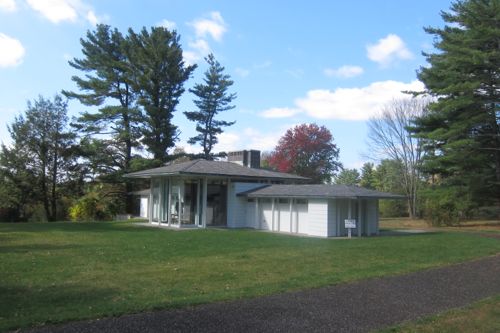
In truth, we were on our way to New York City for 24 hours of birthday fun and I figured why not squeeze a quick museum in on the way to the train. (Which is part of the whole “she loves me back” thing – for this has just become how we operate. I plan, she accepts that the plans will work out.)
Anyway, if you are reading this page that tells me you at least care a little bit about modern architecture. And upon seeing New Canaan above you may have said to yourself, “Ah, one of the centers of mid-century design!” And good for you.
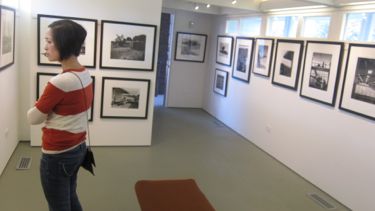
And back to Hoang… I never gave a hoot about design or architecture before I met her. I certainly never appreciated the subtle, austere and beautiful aspects of “steel and glass” and mid-century modernism. She has taught me much. So much so, that I’ve fallen in love with many of the designers and architects of the period. (Eliot Noyes is my favorite by the way.)
Attentive readers remember our visit to Philip Johnson’s Glass House – also in New Canaan – and how Hoang actually had a rather important hand in its status as a National Historic Landmark.

Anyway, in 1946, Pamela and Landis Gores purchased a four-acre lot to construct their first home in New Canaan. The house, which is still standing and owned by the Gores family, was one of the first Modern houses built in New Canaan.
Across town is the Gores Pavilion, located in Irwin Park off of Weed Street. It was built in 1960 and is but one of scores of modern buildings in New Canaan. Gores’s clients were Jack Irwin, U.S. ambassador to France and an Undersecretary of State, and his wife, Jane Watson, whose father was the founder of IBM. Designed as a pool house and personal lodge for the Irwins, it is set about a hundred yards from the Irwins’ more conventional house, in New Canaan’s Irwin Park. When it was threatened with demolition in 2006, supporters of modern architecture, led by the New Canaan Historical Society, rallied to protect it.

The historical society goes on to say that “the Gores Pavilion now serves as a museum and cultural center highlighting the legacy of New Canaan’s modern architects and architecture. It offers exhibit and meeting space for artists, students, and town residents. It is also a symbol of the New Canaan Historical Society’s commitment to raising awareness of and protecting our Town’s extensive modern heritage.”
We arrived and drove through Irwin Park to the back lot where the Pavilion stands. It’s not large by any stretch and the pool itself has been filled in. it is, however, still a lovely little piece of mid-century beauty.
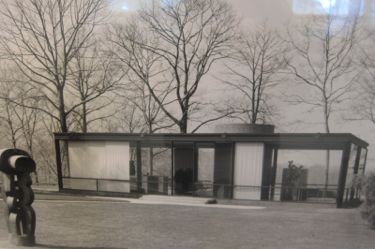
During our visit, there was two exhibits – and I assume the one about the New Canaan moderns is more or less permanent. The temporary one, Pedro E. Guerrero, 1917-2012, Photographs of Modern Life was a very nice retrospective of the moderns around the country, with a focus on the local area of course.
Pedro E. Guerrero was the photographer for three of America’s most famous artists: architect Frank Lloyd Wright and sculptors Louise Nevelson and Alexander Calder. Guerrero’s six-decade career included long-term relationships with each of these individuals. (Calder lived in Connecticut, by the way.)
Photographer Pedro E. Guerrero began his photographic career in 1939 when acclaimed architect Frank Lloyd Wright (1867-1959) retained him to document his buildings and his Taliesin Fellowship of apprentice architects. Over a span of 20 years, Guerrero recorded Wright and his work becoming the master architect’s chief visual interpreter.
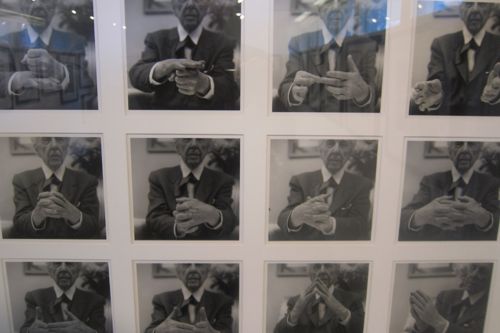
Frank Lloyd Wright by Guerrero
Guerrero worked for all the major architecture and home magazines in the 1940s-1970s. His work has been exhibited at major museums and galleries in the U.S. and in Europe and has been featured in books, magazines and documentary films.
Through the work for magazines and such, Guerrero documented buildings modernists from Eero Saarinen to Joseph Salerno. Quick, name a building in Connecticut that each has designed? I’ll go first: Ingalls Rink at Yale (my visit, here and a bad picture of the picture just below) and United Church of Rowayton (which is a cool building).
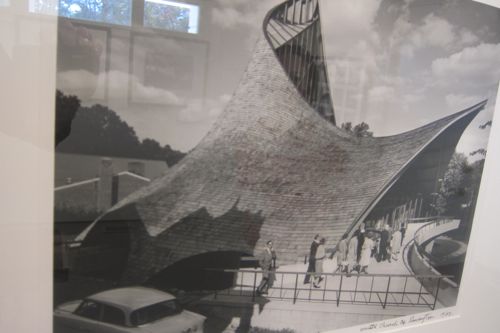
United Church of Rowayton
He also photographed the work of “The Harvard Five,” which I supposed I should name if you don’t know already: John Johansen, Marcel Breuer, Gores, Johson, and Noyes. Guerrero approached the modern buildings as sculpture rather than functional architecture. Wright features the most prominently in the work, but enough of the Harvard Five guys were represented in the exhibit to make us happy.
We crossed through a small kitchen area to access to other wing of the pool house. Here, there was another photographic exhibit. This time, it was a “Second Look at New Canaan Architects, 1953-1983.) I guess we missed the first look when the Pavilion first opened after its restoration.
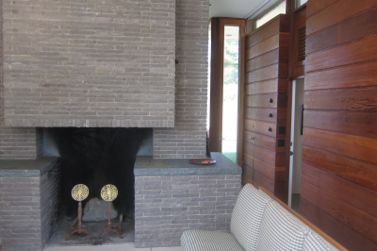
All the usual suspect (photos) are here. Still, it’s always cool to note how important, relatively, the New Canaan scene is in the world. It truly is one of the centers of modern architecture in the entire world.
There were more here than the famous Harvard Five, but those are of course the main guys. Each of the five brought a slightly different perspective to architecture. Philip Johnson was the eloquent experimentalist. Gores was interested in the early work of Frank Lloyd Wright and his singularly American view of architecture. Noyes, who was imbued with functionalism, experimented with new concepts of plan and building enclosure. Johansen became innovative in his use of form, plan and materials. Breuer, steeped in the purist tradition of the International Style, remained its spokesman.
The photos in the exhibition included many of students’ work of the Harvard Five. Their buildings are, of course, all over the world and in the brochure’s words, “included in the exhibit are personal interpretations and re-thinking of the International style, restorations, eclecticisms, and post-modern allusions to our past.
Or, in my words, “a bunch of pictures of cool buildings.”
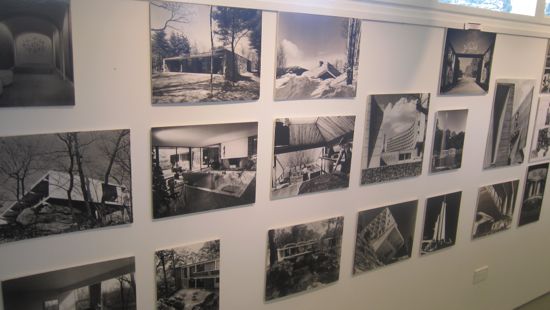
As Hoang and I were poking around the room, recognizing various buildings here and there, the woman running the show poked her head in and asked how we were doing. She then challenged us in her New Canaan patois, “do you think you know a lot about the moderns?”
My wife, who studied architecture, modestly said that she knew the basics. So the lady points at some random guy – here on the right in this picture below – and asks her if she knows who that is:
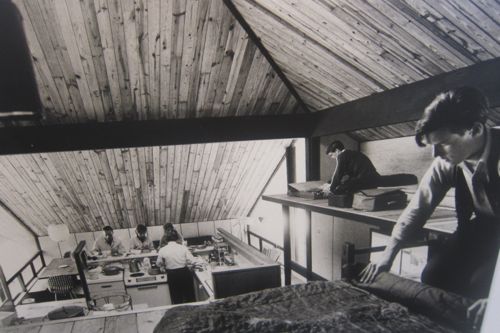
Who’s the guy on the right?
No, she did not. And I certainly didn’t. The lady then said, “If you were a good republican, you’d know.” As neither of us would qualify for that, we gave up.
Do you know?
Of course you don’t. How could you? It’s apparently Paul Bremer, the Iraq War buffoon. The lady walked away in triumph. I have no idea why, as her question was ridiculous.
I just looked up Bremer and learned, “Born in Hartford, Connecticut, Bremer was educated at New Canaan Country School, Kent School and Phillips Academy. Bremer’s father was president of the Christian Dior Perfumes Corporation in New York. His mother was a lecturer in art history at the University of Bridgeport. Bremer graduated from Yale University in 1963…” So yeah, lots of local history in his bones.
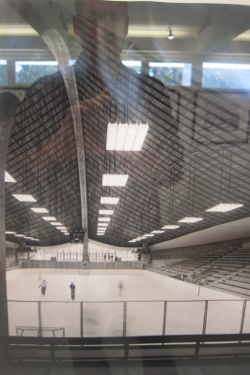
Ingalls Rink
So what’s the connection? Landis Gores designed a few of the buildings at the New Canaan Day School where Bremer was a student.
The common room area of the Gores Pavilion is really quite nice. His signature oversized fireplace is there as the focal point. The lady was pretty occupied with some older guy in a blazer who didn’t seem to flinch at the many hundreds of dollars the bi-annual New Canaan modern architecture tour costs. (I still want to do it with Hoang some day.)
But I should mention how cool I think it is that New Canaan (and Westport too, to some degree) has embraced their modern history with such gusto. They have come to recognize their place in history may really only be 50-70 years old – but just as important as anything else in Connecticut.
We poked around a bit more and listened to the lady talk about how her personal furniture at her house will be used for the next exhibit about furniture because hers is “just so beautiful.” The furniture here in the Gores Pavilion was fairly sparse, but it was designed by some guy named Jens Risom. Frank Lloyd Wright was fond of calling interior decorators “inferior desecraters.” So when I client asked Wright about using furniture not designed by Wright, it is impressive that he responded simply with “Risom O.K.”
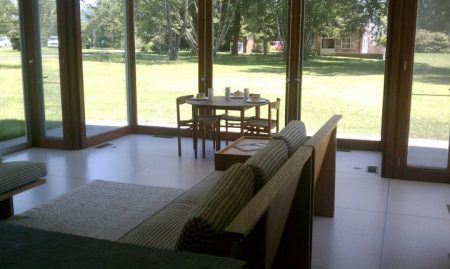
Risom lives in New Canaan too and was one of the first designers to bring traditional Scandinavian values of function and craftsmanship to America. The guy has been prolific and much-awarded. To me, his stuff is nice but I wouldn’t seek it out.
There are certain conversations like the one with the lady about her furniture which you will really only hear in New Canaan, CT. Randomly, here’s a Yelp review of some bakery in town, which sums up the town beautifully.
And since it was Hoang’s birthday, and since she’s stunningly beautiful, I’m going to pop in a picture of her here from very late at night that night in Manhattan.

I am one lucky man.

 Chris says
Chris says
October 29, 2013 at 3:35 pmThe Bremer family had a house in New Canaan by Eliot Noyes. There’s a photo of it here. Nice house, whatever the political connections.
 Steve says
Steve says
October 29, 2013 at 4:11 pmOh wow, thanks. Yet another beautiful Noyes effort.